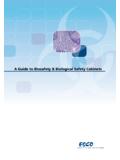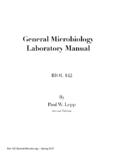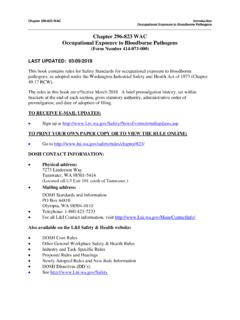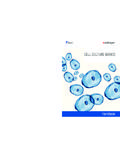Transcription of Biological agents: Managing the risks in laboratories …
1 Biological agents: Managing the risks in laboratories and healthcare premisesAdvisory Committee on Dangerous PathogensHealth and Safety ExecutiveINTRODUCTION1 Scope1 Purpose of guidance1 COSHH3 Biological agents3 Biological agents at work scope of guidance5 PART 1 Managing HEALTH AND SAFETY7 Health and safety legislation and Biological agents7 Health and safety management 8 Health and safety policies 8 Access to competent help 9Co-operation and co-ordination 9 Risk assessment 10 Controlling the risks 11 Use and maintenance of controls 14 Information, instruction and training 15 Handling incidents/emergency planning 16 Health surveillance and occupational health 17 Exposure records19 Other relevant legislation and guidance19 PART 2 WORKING IN HEALTHCARE21 Introduction21 Human healthcare21 Animal healthcare22 Infection control22 Approach to assessment23 Assessing the risks24 Air handling29 Security and access30 Disinfection and disposal procedures31 Protective equipment procedures32 PART 3 WORKING IN THE LABORATORY34 Introduction34 What kind of work?
2 34 What containment measures are required35 Part 3A Working with Biological agents36 Part 3B Working with materials that may containbiological The Reporting of Injuries, Diseases and Dangerous Occurrences Regulations Transport of infectious Other relevant legislation and Classification of animal COSHH controls and healthcare guidance Cell Work with Hazard Group 3 parasites71 REFERENCES74 FURTHER INFORMATION80 Biological agents: Managing the risks in laboratories and healthcare premisesContentsScope 1 This publication provides guidance on your duties under the Control ofSubstances Hazardous to Health Regulations 2002 (COSHH)1, 2(as amended) asthey relate to Biological agents (micro-organisms/infection risks ).
3 In the past, theAdvisory Committee on Dangerous Pathogens (ACDP) has issued COSHH-basedguidance primarily for the laboratory sector. However, some of their publications,eg on blood-borne viruses and transmissible spongiform encephalopathies, haveincluded guidance for healthcare professionals. 2 This guidance covers: work in all types of laboratories where Biological agents are handled. Thisincludes research, teaching, clinical, forensic, veterinary and environmentallaboratories. It covers both deliberate use of Biological agents and work withmaterial that contains or could contain Biological agents; and work with infected patients in human and animal healthcare 1 contains guidance on some general health and safety issues, such ashealth and safety management, that are applicable to all the relevant overview of the assessment and management of risks from Biological agents isalso given.
4 4 Part 2 contains more specific guidance on assessment and management ofwork involving infected patients in human and animal healthcare 3A covers work in laboratories where Biological agents are intentionallyhandled eg propagation and 3 Bcovers work in laboratories where potentially infectious material of guidance7 This guidance is aimed at all those who have responsibility for assessing andmanaging the risks from exposure to Biological agents at work in either a laboratoryor a healthcare setting. For example, you may be a Biomedical Scientist Grade 3(BMS3) in a National Health Service (NHS) laboratory, or principal investigator in auniversity laboratory, a clinical director, a nurse manager, or the veterinary managerof a veterinary hospital.
5 Safety advisors, Biological safety officers and other safetyprofessionals may also find the guidance useful when providing competent adviceto their addition to COSHH1this guidance also provides advice on duties in otherhealth and safety legislation as it relates to work with Biological agents. (See Part 1 Managing health and safety). Figure 1 illustrates the main legislation covered byIntroductionBiological agents: Managing the risks in laboratories and healthcare premises1 Specific health andReporting of Injuries,Carriage of Dangerous Genetically Modifiedsafety legislationDiseases and Goods (Classification,Organisms (Contained Dangerous Occurrences Packaging and Use) Regulations7 Regulations5 Labelling) Regulations6 Biological agents: Managing the risks in laboratories and healthcare premises2 Figure 1 Legislation and guidance for work with Biological agents Primary legislationHealth and Safety at Work etc Act3 GuidanceLaboratoriesHealthcareACDP guidanceBiological agents.
6 Managing the risks in laboratories and healthcare premisesProtection Against Blood-borne Infection in the Workplace: HIV and Hepatitis8 Transmissible Spongiform Encephalopathy Agents: Safe Working and the Prevention of Infection9 Management and Control of Viral Haemorrhagic Fevers10 The management, design and operation of microbiological containment laboratories11 Working safely with research animals: Management of infection risks12 Other HSC/ESafe disposal of clinical waste13guidanceSafe working and the prevention of Safe working and the prevention of infection in clinical laboratories and infection in the post mortem room15similar facilities14 Advisory Committee on GeneticModification: Compendium ofguidance16DH/NHS guidanceAccommodation forGuidance for Clinical Health Care Workers:Pathology Services17 Protection Against Infection with Blood-borne Viruses18 Hospital Infection Control19 The prevention and control of tuberculosis in the United Kingdom20 Infection control in the built environment21 General health and Control of Substances Hazardous toManagement of Health andsafety regulationsto Health Regulations1 Safety at Work Regulations4this guidance.
7 It also shows the key guidance issued by the Health and SafetyExecutive (HSE) and other government departments that covers work withbiological agents in the laboratory or healthcare setting. Guidance on other areas,eg agriculture or controlling the risks from legionella bacteria, is not included. 9 Not all of the guidance is issued by HSE, but the listed publications all containinformation that should assist you in complying with your duties under health andsafety The guidance for laboratories has previously been aimed at those whodeliberately work with Biological agents. The containment and control measuresgiven in COSHH1and ACDP guidance have also, quite rightly, been applied inareas where there is work with potentially infectious material.
8 This includes routinepathology disciplines (haematology/blood transfusion, chemical pathology,immunology, cellular pathology, genetics and cytology), university research andteaching laboratories , forensic laboratories or food testing laboratories . 11 This guidance now covers these latter areas more explicitly in line covered for the first time is incidental exposure in the healthcaresetting (both human and animal). ACDP considers this to be the highest risk ofexposure outside the laboratory. ACDP has also issued guidance on riskassessment for other occupations where there may be incidental exposure,Infection at work: controlling the The intention is that this publication links the specific pieces of ACDP guidance, and provides advice on the central themes of Managing the risks frombiological agents at work, such as risk assessment.
9 It does not duplicate the morespecific guidance, eg on containment requirements, but signposts the reader toother appropriate publications, both ACDP and the Department of Health(DH)/NHS The Biological agents provisions in COSHH were changed in 2002. The mainchanges were to move all of the general provisions, including those on riskassessment and control of Biological agents, to the main body of the COSHHR egulations. Only those additional measures relating to work with Biological agentsremain in Schedule 3 to the Regulations. An Appendix to the main COSHH ACOP2supplements the A number of other minor changes have been made including: clarification of definitions used, eg use and handling ; better explanation of the application of derogation - exemption certificates areno longer used (see also Parts 3A and 3B of this document); clarification and extension of the notification duties required for biologicalagents (see paragraph 153).
10 And minor amendments to the containment measures in Part II of Schedule agents 15 A Biological agent is defined in COSHH1as: a micro-organism, cell culture, or human endoparasite, whether or not geneticallymodified, which may cause infection, allergy, toxicity or otherwise create a hazardto human health. Biological agents: Managing the risks in laboratories and healthcare premises316 Most Biological agents are micro-organisms, ie bacteria, viruses, fungi,microscopic endoparasites such as the malarial parasite, amoebae andtrypanosomes and the microscopic forms of the larger endoparasites such as theova and larval forms of helminths. A micro-organism is defined in COSHH1as: a microbiological entity, cellular or non-cellular, which is capable of replication or oftransferring genetic material.
















